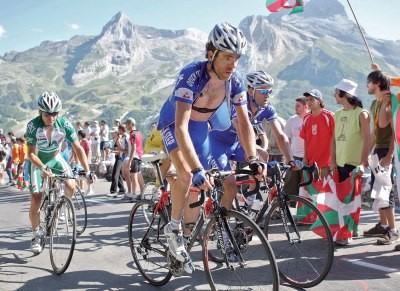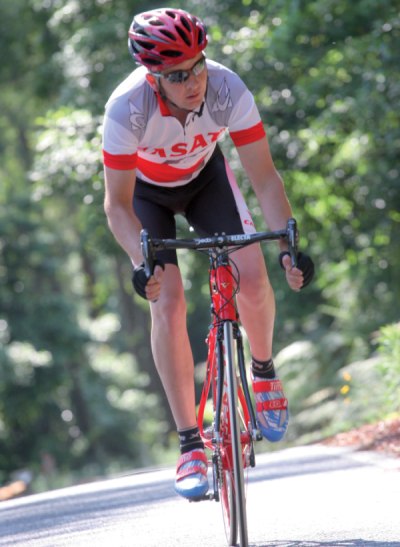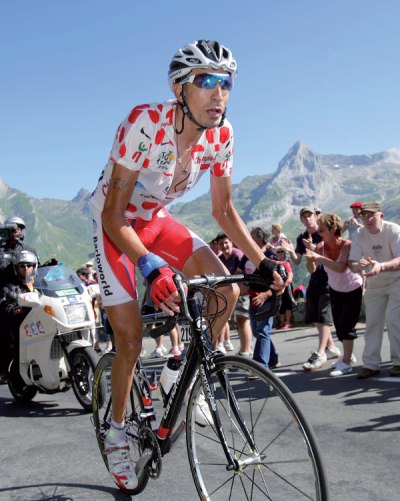I chose the Audax Alpine Classic ride as the focal point for the training program that this series of articles will cover. In part it is because of the popularity of the Classic and because of the benefits of specific preparation for an event with so much climbing in it. These exercises would apply equally well to a cyclist heading off to France to ride l’Etape du Tour in 2009 or any other big mountain event (such as Nove Colli in Italy every May or Fitz’s Challenge in Canberra every October). Combine the inspiration of this Tour issue of Bicycling Australia with the first instalment of a series of five articles on training Alpine Classic, throw in a little George Lucas and we have ‘Episode 3: Climbing Big Hills’. Just so everyone knows where this will go in future issues, the next instalment is ‘Episode 4: Developing Speed’, followed by the conclusion ‘Episode 5: Putting it All Together’. After that, in true Star Wars fashion, we head back to the beginning with ‘Episode 1: Basic Fitness’ and finally ‘Episode 2: A Training Schedule’. Whether you think, like Star Wars, that starting in the middle of the sequence is loopy or inspired, depends on your point of view. But everyone will benefit from the sum total of the programs regardless of where we start.

Ingredient Number One: Le Tour de France
The most important race in cycling. Three weeks in July of mad sprinting, of impossibly fast time trials and especially of seemingly endless climbs in the Alps and the Pyrenees. I often feel motivated in my cycling by the famous Tour climbs such as Plateau de Beille, Hautacam, Mont Ventoux, Col du Galibier and l’Alpe d’Huez. Ingredient Number Two: The Audax Alpine Classic. Arguably the most difficult single day cycling event in Australia. Two hundred kilometres with four nasty ascents. While it might not command the attention of the climbs in Europe, these Victorian climbs are nearly as big and the riding is every bit as epic. It is also a whole lot easier to get to them.
Training for the Alpine Classic
One of the basic principles of training is that you only get better at what you do in training. Given the comparative flatness of the Australian countryside, the only really good way to prepare for the Alpine Classic is to live in Bright and be able to regularly attack the many climbs such as the roads up Mt Buffalo and Mt Hotham. For the rest of us, lots of work on short climbs will have to suffice if we want to develop the ability to do the big climbs without ever having done one in practice. The essential ingredient in climbing prowess is a high power to weight ratio. Legendary climbers in the pro ranks can generate more than seven watts per kilogram of body weight for the hour that a big climb lasts. Even if a cyclist can never aspire to such heights of athleticism, the principal of increasing power output and reducing total mass still applies. With a large wallet, the bicycle can be reduced to around five kg for an event like the Alpine Classic. The UCI might frown upon such light machines, but the Audax society is rather different. The remainder of this article will look at ways to improve the rider rather than improving the bicycle.

Hill Repeats
The first component of any training program, whether conquering a big ‘col’ or something smaller, is the hill repeat. This exercise satisfies multiple requirements in one session. It builds strength, it works on technique and it develops aerobic capacity. There is even some element of building lactate tolerance in it. It is impossible to go wrong with the hill repeat. These should be done once a week (not in recovery weeks) for a great portion of the season, and twice a week maximally. The ideal road for the hill repeat is between three percent and six percent in grade. The gradient should also be relatively constant. Length must be long enough to achieve a five minute ascent, but 10 minutes is better. Something quiet without too much traffic is a nice touch, but certainly a busy road will not ruin the training effect. Hill repeats are performed seated throughout. The gearing should be large enough to bring the cadence down to around 60 rpm for those who have not done this sort of training before. Using a lower cadence builds strength more quickly but it is only OK for those riders who know that it will not hurt their knees, hips or back. Ideally the heart rate response for this activity is fully aerobic. That is, heart rate stays below the lactate threshold because the stress is on the large leg muscles only. In practice, all but the fittest riders either creep into the anaerobic level or spend the entire effort there. Be aware that the ideal of staying in the aerobic zone provides a goal that might never be achieved. An absolute novice at this should start out with two hill repeats of approximately 10 minutes (if the hill is a little longer than this, just use the whole hill but if it is a 20+ minute climb stop part way up). For the Alpine Classic the aim is to replicate an hour of climbing which equates to six repeats. To put it in some perspective, those racing in Europe at the elite level will do 12 or more of these 10 minute efforts prior to going overseas. The hill repeat is done with a minimal break in between ascents. From reaching the top, turn the bike around and head back down to an immediate start of the next effort. I encourage all of the cyclists I coach to ‘leave one in the bag’ when doing the hill repeat. This is a short way of saying this drill is not done to exhaustion, rather each one should be a full effort and it is better to do one too few than one too many.
Climbing Intervals
After the hill repeats are an established part of the training program, (say three months of once per week), then it is time to add in the climbing intervals. These are done once per week at least 48 hours prior to the hill repeats. The same section of road works very well for both exercises. Where the hill repeat is generally done more slowly than the same hill would be climbed in a race, the climbing interval is done more quickly than race pace. Where the hill repeat is done at a low cadence in a large gear, the climbing interval is done at a very high cadence in a small gear. The heart rate during these intervals will be very high. The combination of climbing a moderate slope and pedalling well over 100 rpm puts a high load on the cardio-vascular system. This exercise helps develop the ability to ‘back up’ efforts in a climb. When you are racing and someone repeatedly puts in a bit of extra pace, this surging will disintegrate a bunch quickly. The climbing interval is one part of learning to cope with the surges. Even in the Alpine Classic, which is not a race, this drill helps to cope with the steeper sections of the long climbs without slowing down over the duration of the ascent. Climbing intervals do not go to the top of the hill, but the finish is defined each session by the first effort. From the bottom, ride as fast as possible with a steady output for four minutes and 30 seconds. Make a mental note of some landmark at this point because each subsequent interval will go to this same point on the hill.
Turn around and cruise down the hill and then ride around the bottom on flat terrain for a total of nine minutes. Then start again with a similar gear and pace as in the first effort. On second and subsequent intervals, the landmark established the first time up is the indication of when to stop, but do not turn off that timer just yet. Typically each interval will be slightly longer than the one before it until eventually it takes more than five minutes. At this time the session has ended. I once trained a cyclist who could do more than 20 of these in one session, which adds up to nearly five hours on the bike. Most people, including him, do not have the time to routinely spend five hours in hill intervals. It is terrific if you have the time, but a better strategy is to lengthen the very first interval so that it is closer to the cut off point from the outset. Four minutes 40 seconds reduces the window to 20 seconds and four minutes 50 seconds reduces it to only 10 seconds long. For those who still run out of time after starting at 4:50, either the scheduled time allowed for this drill is unrealistic or I have a professional contract for you to sign.

Standing Climbing
On long climbs it is imperative to stand occasionally to provide relief to back and leg muscles. Standing uses more energy and is difficult to do for long periods of time, but a good 15-30 seconds out of the saddle every few minutes in an hour long climb will do wonders for the body. It is difficult to develop this standing and sitting alternating rhythm without lots of long climbs to ride and have it emerge naturally. In lieu of big mountains to practice on, a mini routine can help to develop the skills, the muscles and the mentality to use this when completing the Alpine Classic. On a moderate hill, it might be the same hill used for the two drills already discussed or something different, start climbing in a moderate gear at a moderate pace. Somewhere in between the hill repeat and the climbing interval in gearing and intensity, but definitely not slowly. Count out about 20 pedal strokes and then stand for five more. Repeat this to the top of the hill using 20 seated and five standing revolutions of the cranks. Several ascents can be put together to make a training session, or this exercise can be incorporated into longer rides every time a hill is climbed. The goal is to be able to climb at the same speed with little increase in perceived effort. For most people, shifting up one gear for the standing phase and then back one gear for the sitting phase will work out well. Mix up the time spent sitting and standing from week to week. Try 50 strokes sitting and 20 standing, then 100 sitting and 50 standing. The exact ratio is not important. What is key, is building up to longer and longer periods of standing at that same pace used sitting. Efficiency will be improved with practice. When standing pay attention to technique. It may help to have an observer watch. Hips should be just above and just in front of the saddle nose, not up near the back of the stem. Even on very steep hills the hips should be kept away from the front of the bike if possible. The front wheel of the bike should track straight, not trace out a zigzag on the road surface. There is no point in riding further than necessary. Adequate abdominal and upper body strength (which is hard to develop outside of a weight room) makes good technique much easier.
Indoor Climbing
With winter upon us, many cyclists take to indoor cycling as a way to keep up some semblance of fitness, especially if you live in a cooler locale. Trainers can be set to simulate climbing just by hoisting the front wheel up higher than normal. An average city Yellow Pages is the correct thickness to level out the bike when mounted on a trainer. Three times that thickness puts the bike in a big hill climbing position. It is important to do as much of the hill training as possible with an elevated front wheel or the cycling position will be all wrong. With the trainer set up in a climbing position, not only can replicas of the above exercises be reproduced in the comfort of the home, butany riding done on a trainer can become a climbing workout. It is even possible (probably nothing like fun, but possible) to climb big mountains from the trainer. With the front of the bike jacked up 10 to 15 cm simulating a 10 to 15% slope (it really is that easy because most bikes have a one metre wheelbase) every ride on it helps acclimatise the body to riding up such grades.
Long and Hilly
The Alpine Classic is a ride that lasts all day and has more than 3.5 km of vertical gain in it. To get the most out of these regular drills, there needs to be an epic ride included in the weekly schedule for the months leading up to Australia Day (the date for the Classic each year). That ride will be epic because it needs to have as much climbing as is available on the local terrain, with the goal being to work up to at least seven hours in the saddle and 2500m of climbing by Christmas. The Classic can be completed without the epic ride, but it makes it much easier and is also good for rider confidence. Never add more than 10% per week to any one exercise (in terms of time OR intensity) and the same rule applies to the entire weekly schedule too. It takes a minimum of 10 weeks by this rule to build up to seven hours from a starting point of three hours. Add in the odd missed week and recovery weeks and four months looks like a better schedule to ramp up from three to seven hours (assuming that three hours is OK at the start).
The Fun Bit
The reward for climbing up a hill, big or small, is the descent. At least it is a reward for most. I have worked on descending skills with dozens of cyclists – it puts fear into more riders than it really should. The Alpine Classic will go much more smoothly if each big descent is taken in a relaxed and easy state. For those who tense up at the thoughts of a 15 minute high speed descent of a twisting mountain road, practice as much as possible prior to the event so that you learn to relax. Take pointers from skilled descenders by trying to follow them down local hills. Look well ahead and relax, especially the hands, shoulders and neck. With a little over six months to go until the Alpine Classic runs for 2009, there is (just) enough time for someone who rides 150-250 km per week to build up their abilities. While this same cyclist could probably complete the Classic without any specific preparation, it will be a much more enjoyable proposition to spend the next few months working in a focussed manner with the expectation that Australia Day will be enjoyed rather than endured. As always, consult your physician before beginning this or any >exercise program.

